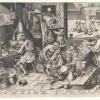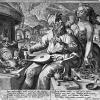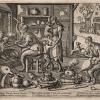David Teniers the Younger, The Alchemist (1643/45)
Commentary
David Teniers the Younger (1610-1690) was a Flemish painter born in a family of artists originating from Antwerp. He was the court painter of Archduke Leopold Wilhelm, the governor of the Southern Low Countries, and the founder of the Antwerp academy of arts.
Teniers was strongly influenced by the Dutch genre painting of alchemists in the laboratory, which traced back to Pieter Breughel the Elder and earlier depictions. These images were usually satirical and negative or at least ambivalent (see related sources on Cabinet).
By comparison, Teniers tried to reform the genre by portraying alchemists as scholars or learned men. In doing so he tried to merge the Dutch genre with the portrayal of the humanist scholar in his study, as in this famous engraving by Albrecht Durer. In the painting above, the alchemist is similarly shown as reading and being surrounded by books.
Teniers imagined the alchemist as someone belonging to the urban middle class like himself. In fact, it has been shown that he probably saw himself as an alchemist, one of several painters to have done so. Teniers's alchemist is sometimes shown as a pure scholar, involved in deep study, but occasionally working at a furnace.
The space the alchemist is depicted in can be identified as a laboratory, but this is usually a household one, incorporated in the alchemist's house. Interestingly, Teniers seldom shows the alchemist alone; several assistants are usually present in the background, working with furnaces and distillation equipment. In other words, the alchemist-scholar is wealthy enough to involve employing others. This is indeed what contemporary alchemical philosophers like Jan Baptist Van Helmont (1579-1644) and Robert Boyle (1627-1691) did.
The equipment depicted in the laboratory is generally very accurate, as Purš and Karpenko have pointed out. See the annotation on the text for some of the instruments used.
Image: David Teniers the Younger, The Alchemist (PRESCRIBED), 1643/45 Credit: Herzog Anton Ulrich Museum. Public Domain.
Commentary. Jo Hedesan (January 2024)
Bibliography.
Ivo Purš and Vladimir Karpenko, The Alchemical Laboratory in Visual and Written Sources (Prague: Academia, 2024)
Lawrence M. Principe, ‘Spaces of Wonder and Ruin: Alchemical Laboratories in Early Modern Painting’, in Art and Alchemy: The Mystery of Transformation, eds. Sven Dupré, Dedo Von Kerssenbrock-Krosigk, and Beat Wismer (Munich: Hirmer, 2014), 60-83.
Elizabeth Berry Drago, ‘Skepticism and Curiosity for the Alchemist at Work’, in A Cultural History of Chemistry in the Early Modern Age, ed. Bruce T. Moran (London: Bloomsbury, 2023), 199-229.





